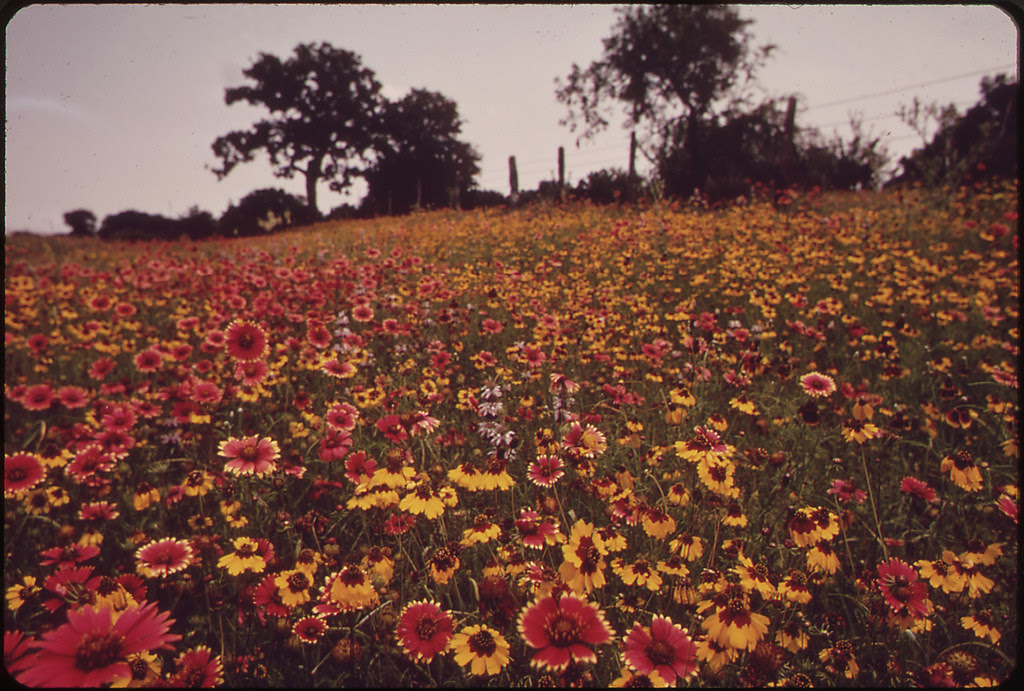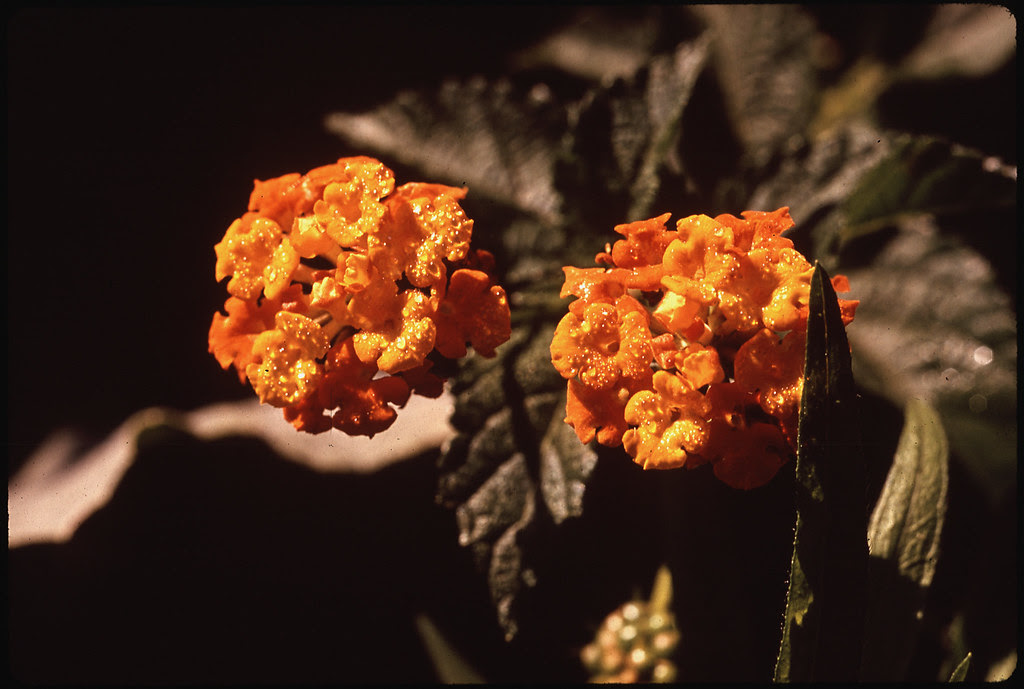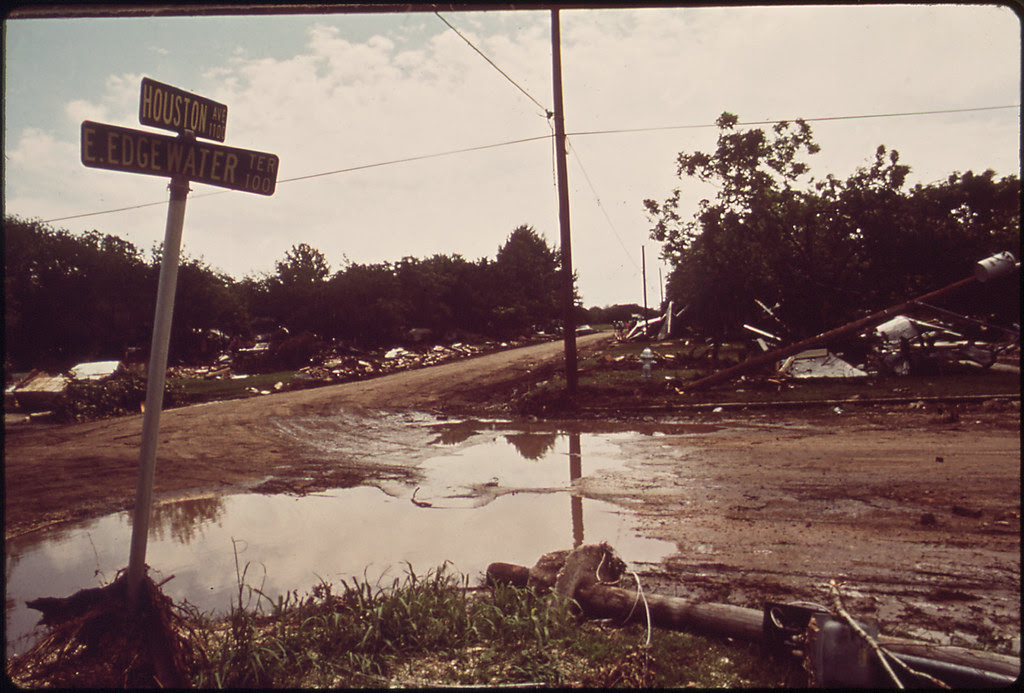.

Lake Lyndon Johnson, Travis County, Texas: photo by Bill Reaves (1934-) for the Environmental Protection Agency Project Documerica, May 1972 (US National Archives)
Into ripples fanning
circles in the freshet
that lapped
the field of flowers
that bathed
the white horse
after the flood

Field of flowers, Inks Lake Reservoir, Texas: photo by Bill Reaves (1934-) for the Environmental Protection Agency Project Documerica, May 1972 (US National Archives)

Flower meadow, Llano, Texas: photo by Bill Reaves (1934-) for the Environmental Protection Agency Project Documerica, May 1972 (US National Archives)

Cactus flower along Devil's Backbone Ranch Road, San Marcos, Hays County, Texas: photo by Bill Reaves (1934-) for the Environmental Protection Agency Project Documerica, May 1972 (US National Archives)

Flowers. Commelina erecta (Commelina), San Marcos, Hays County, Texas: photo by Bill Reaves (1934-) for the Environmental Protection Agency Project Documerica, May 1972 (US National Archives)

Sunflowers, Ingram, Kerr County, Texas: photo by Bill Reaves (1934-) for the Environmental Protection Agency Project Documerica, May 1972 (US National Archives)

Flower. Cirsium texanum (Texas Thistle), Lake Austin, Matagorda County, Texas: photo by Bill Reaves (1934-) for the Environmental Protection Agency Project Documerica, May 1972 (US National Archives)

Texas -- Near Lake Austin, Matagorda County: photo by Bill Reaves (1934-) for the Environmental Protection Agency Project Documerica, May 1972 (US National Archives)

Wildflowers. Helenium (Sneezeweed). Near Lake Austin, Matagorda County, Texas: photo by Bill Reaves (1934-) for the Environmental Protection Agency Project Documerica, May 1972 (US National Archives)

Wildflowers. Near Lake Austin, Matagorda County, Texas: photo by Bill Reaves (1934-) for the Environmental Protection Agency Project Documerica, May 1972 (US National Archives)

Flowers. Lantana camara (Lantana), Lake Austin, Matagorda County, Texas: photo by Bill Reaves (1934-) for the Environmental Protection Agency Project Documerica, May 1972 (US National Archives)

Lake Buchanan, Llano County, Texas: photo by Bill Reaves (1934-) for the Environmental Protection Agency Project Documerica, May 1972 (US National Archives)

Central Texas. Near Lake Travis, Travis County: photo by Bill Reaves (1934-) for the Environmental Protection Agency Project Documerica, May 1972 (US National Archives)

Central Texas. Near Lake Travis, Travis County: photo by Bill Reaves (1934-) for the Environmental Protection Agency Project Documerica, May 1972 (US National Archives)

South Central Texas: photo by Bill Reaves (1934-) for the Environmental Protection Agency Project Documerica, May 1972 (US National Archives)

Detail of havoc caused by flooding of Guadalupe River, New Braunfels, Comal County, Texas: photo by Bill Reaves (1934-) for the Environmental Protection Agency Project Documerica, May 1972 (US National Archives)

River flood damage, New Braunfels, Comal County, Texas: photo by Bill Reaves (1934-) for the Environmental Protection Agency Project Documerica, May 1972 (US National Archives)

Guadalupe River flood damage, New Braunfels, Comal County, Texas: photo by Bill Reaves (1934-) for the Environmental Protection Agency Project Documerica, 1972 (US National Archives)
The EPA sent Texas photographer Bill Reaves to document the damage wreaked by flash flooding in the Guadalupe River watershed of central and south central Texas on 11-12 May 1972. A swift rise in the river caused by heavy rains following a long period of drought destroyed buildings, prompted nighttime evacuations, left families homeless and scrambling for shelter, and drowned at least fifteen persons. Reaves's portfolio shows the widespread devastation. What's most striking about his file however is not the disaster-reckoning but the documentation of the resiliency of the natural landscape of the region.
ReplyDeleteDo my weepy old eyes deceiver, or is that dappled patch of white-spotted brown well-camouflaged in a thicket in the sixth from last photo not a sleeping deer, most likely young?
(And likely in no hurry to run into the sport hunters camping in the same neighbourhood, as pictured in the nether stretches here.)
This cumulative tale comes so dearly to those last two shining lines.
ReplyDeletethe flood - as judgement.
light poured - as blessing.
How familiar this is. I used to live just a few blocks from that signpost in the last photo—in antediluvian days, mind you—right on the Comal River, one of several that flooded so disastrously and lethally. A few months after the event, while paying a visit to family in New Braunfels, I saw a pickup still lodged maybe twenty feet up in a tree, on an island in the middle of the Comal. The poem has the vitality and confidence of a comeback such as we’d hope to find in Mother Nature, or at least used to . . . and even in ourselves here and there. Beautiful.
ReplyDeleteBeautiful, Tom, beautiful poem.
ReplyDeleteThanks very much Duncan, Hazen and Red.
ReplyDeleteHazen, it's a happy thing your visit to that family in New Braunfels did not come on the night when the rain came down so hard and the racing river ran so fast and rose so swiftly, it must have seemed the end of the world.
That's a flood against which later floods were still being measured forty years later, when the next big one came.
There were of course some hard human stories that went with it.
But as Bill Reaves allows us to remember, that also may have been the best springtime ever, for the wildflowers.
Looks like a deer from here.
ReplyDeleteMy family lived upland, safe from flooding. Under normal conditions, there were water moccasins aplenty in those rivers—another force of nature. The floodwaters from the Comal and the Guadalupe brought lots of them into houses, and people and pets got bitten.
Texas and wildflowers, whole fields of them in spring; there’s nothing more lovely. You need some bluebonnets in there, Tom.
Speaking of humans immersed in nature . . . one summer day in better times, at The Island where we swam in the cold Comal, I watched a water moccasin come undulating down the middle of the stream, it’s head just above the surface. Swimmers, including your correspondent, made immediately and respectfully for the banks on either side. This also was nature asserting itself, a warning that the river was not just ours . . . and in fact never was.
Hazen,
ReplyDeleteBill Reaves's file is short on Water Moccasins and Bluebonnets... though of course, as you'd know, Texas isn't.
As to the former, my current #1 favourite Texas herpetological photographer captured this dangerous beauty. He doesn't speak to size, but as three to four feet in length might be considered about average for an adult water moccasin, I'd guess this one would probably be at least that big. (One learns that two of these big fearsome critters measuring over five feet in length have been "taken" in Yazoo City, Mississippi, though it's unclear exactly who were the takers.)
Western Cottonmouth Water Moccasin, Jesse H. Jones Park & Nature Center, Humble, Harris County, Texas: photo by Patrick Feller, 21 March 2012
Mr. Feller also spotted a wee young'un, in the road, three weeks later.
Juvenile Western Cottonmouth Water Moccasin, Jesse H. Jones Park & Nature Center, Humble, Harris County, Texas: photo by Patrick Feller, 5 April 2012
That one was obviously a whole lot smaller. For the scale, here's a second view, evidently taken by the photographer's wife. ("Liz shot me with her i-phone while I was shooting the little snake."):
Juvenile Western Cottonmouth Water Moccasin and me, Jesse H. Jones Park & Nature Center, Humble, Harris County, Texas: photo by Patrick Feller, 5 April 2012
And not forgetting the bluebonnets: my researches indicate that the most magnificent display yet captured in the vicinity of Comal is that produced by a fellow whose next shot, in the stream, shows a display of the heads of Texas big game mounted on the wall. But you already knew Texas is another planet.
A field of bluebonnets, Comal County, Texas: photo by Vernon's Pictures, 2 April 2007
Just to put some numbers on that night, Hazen, this from the state hydrological records:
ReplyDelete1972, May 11 to 12; New Braunfels: During a 4-hour period, 16 inches of rain fell in the San Marcos area in Hays and Caldwell Counties. The National Weather Service reports that about 12 inches of rain fell in about 1 hour. Seventeen lives were lost to the rampaging floodwaters that inundated 400 homes and caused about $17.5 million in damages.
And here's something a bit more recent:
Jason Boland and the Stragglers: Comal County Blue
(Those guys are from Oklahoma -- go figure.)
By the by... Bill Reaves doesn't have a car in a tree. But he has a mattress impaled in a tree. Somebody had been sleeping on it, not long before.
Wow. Jason Boland and The Straggler are so fine. He sings about taking Hunter Road up to Austin. Did that many a time. And sometimes on the comeback I took Devils Backbone (mentioned in that fourth photo, of the cactus flower) through the Hill Country cedars on a cold, bright December day.
ReplyDeleteVery interesting
ReplyDeleteI took the journey from the white horse in the stream to the corner of Houston Ave. and E. Edgewater Terr., and then back. It is a moving story no matter which direction you take. Maybe it is meant as a roundtrip?
ReplyDelete-David
Thanks Mr. Brown (suddenly this feels a bit like the diner set-up scene in Reservoir Dogs), and David.
ReplyDeleteDavid, as to the structure of the thing, what I've done here, as often, is work through a loose file of a great many photos, and then impose a sort of order -- said order, entirely my own devising, not by any means meant to be blamed on the photographer.
But as you mention it, this is a particularly pertinent point here.
The photos in the Reaves file are predominantly scenes of wreckage. My ordinary way of doing things would be to foreground the disaster aspect (and with a disaster, that's ordinarily a pretty important aspect).
But here, I couldn't help feeling that the photographer's eye was better trained to discover the natural beauty that sprang up from the disaster, and that that aspect was also the real burden to be taken away and treasured.
Had I done it not "back to front" like this, but "front to back", we'd have seen a lot of beached boats and smashed-up houses, with perhaps a volunteer wildflower or two mixed in for completeness' sake.
Anyhow, circumstances alter cases, obviously. But it's relevant you've brought his up, and I thank you for that.